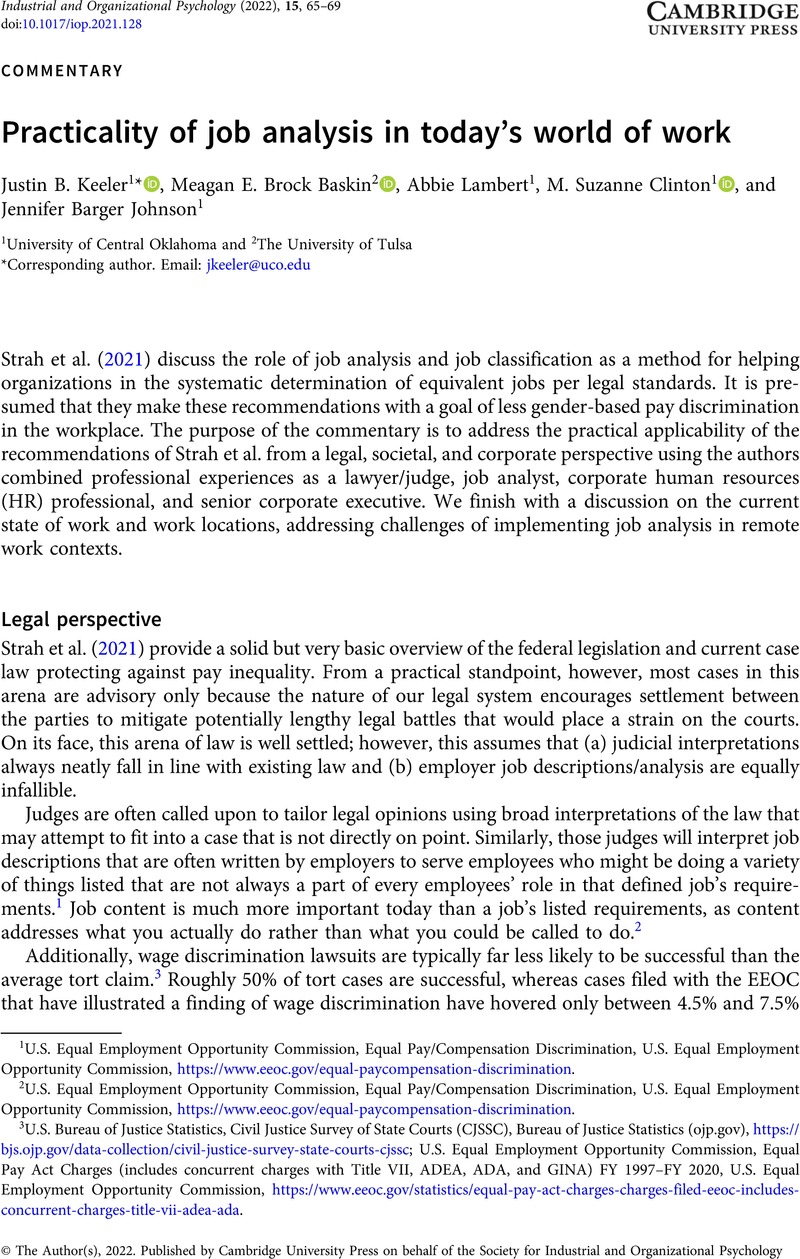No CrossRef data available.
Article contents
Practicality of job analysis in today’s world of work
Published online by Cambridge University Press: 29 March 2022
Abstract
An abstract is not available for this content so a preview has been provided. Please use the Get access link above for information on how to access this content.

- Type
- Commentaries
- Information
- Copyright
- © The Author(s), 2022. Published by Cambridge University Press on behalf of the Society for Industrial and Organizational Psychology
References
Allen, T. D., Golden, T. D., & Shockley, K. M. (2015). How effective is telecommuting? Assessing the status of our scientific findings. Psychological Science in the Public Interest, 16(2), 40–68. https://doi.org/10.1177/1529100615593273
CrossRefGoogle ScholarPubMed
Bartik, A. W., Cullen, Z. B., Glaeser, E. L., Luca, M., & Stanton, C. T. (2020). What jobs are being done at home during the COVID-19 crisis? Evidence from firm-level surveys National Bureau of Economic Research Working Paper 27422. https://www.nber.org/system/files/working_papers/w27422/w27422.pdf
Google Scholar
Cruz, C., Firfiray, S., & Gomez-Mejia, L. R. (2011). Socioemotional wealth and human resource management (HRM) in family-controlled firms. In Joshi, A., Liao, H., & Martocchio, J. J. (Eds.), Research in personnel and human resources management (Vol. 30, pp. 159–217). Emerald Group Publishing. https://doi.org/10.1108/S0742-7301(2011)0000030006
CrossRefGoogle Scholar
Daly, J. (2019, September 3–5). Gender and job crafting: Understanding the role of gendered behaviours in the abilities and motivations to proactively craft work [Paper presentation]. BAM2019 Conference Proceedings, Birmingham, UK. http://eprints.whiterose.ac.uk/150955/
Google Scholar
Dierdorff, E. C., & Aguinis, H. (2018). Expanding job crafting theory beyond the worker and the job: Extendiendo la creación del puesto más allá del trabajador y el puestoEstendendo a criação do posto de trabalho além do trabalhador e do posto. Management Research: Journal of the Iberoamerican Academy of Management, 16(3). https://doi.org/10.1108/MRJIAM-08-2017-0773
Google Scholar
Goldstein, I. L., Zedeck, S., & Schneider, B. (1993). An exploration of the job analysis-content validty process. In Schmitt, N., Borman, W. C., & Associates (Eds.), Personnel selection in organizations (pp. 3–34). Jossey-Bass.Google Scholar
Kamouri, A., & Lister, K. (2020). Global work-from-home experience survey. Global Workplace Analytics. https://globalworkplaceanalytics.com/telecommuting-statistics
Google Scholar
Michiels, A. (2017). Formal compensation practices in family SMEs. Journal of Small Business and Enterprise Development, 24(1), 88–104. https://doi.org/10.1108/JSBED-12-2015-0173
CrossRefGoogle Scholar
Morgeson, F. P., & Campion, M. A. (1997). Social and cognitive sources of potential inaccuracy in job analysis. Journal of Applied Psychology, 82(5), 627–655. https://doi.org/10.1037/0021-9010.82.5.627
CrossRefGoogle Scholar
Nielsen, K., Antino, M., Sanz-Vergel, A., & Rodríguez-Muñoz, A. (2017). Validating the Job Crafting Questionnaire (JCRQ): A multi-method and multi-sample study. Work & Stress, 31(1), 82–99. https://doi.org/10.1080/02678373.2017.1293752
CrossRefGoogle Scholar
O’Mahony, J., & Ma, S. (2017). Connected small businesses US. Deloitte. www2.deloitte.com/content/dam/Deloitte/us/Documents/technology-media-telecommunications/us-tmt-connected-small-businesses.pdf
Google Scholar
Pynes, J. E. (2008). Human resources management for public and nonprofit organizations: A strategic approach (Vol. 30). John Wiley & Sons.Google Scholar
Rudolph, C. W., Allan, B., Clark, M., Hertel, G., Hirschi, A., Kunze, F., Shockley, K., Shoss, M., Sonnentag, S., &
Zacher, H. (2021). Pandemics: Implications for research and practice in industrial and organizational psychology. Industrial and Organizational Psychology, 14(1–2), 1–35. https://doi.org/10.1017/iop.2020.48
CrossRefGoogle Scholar
Sanchez, J. I., & Levine, E. L. (2012). The rise and fall of job analysis and the future of work analysis. Annual Review of Psychology, 63, 397–425. http://doi.org/10.1146/annurev-psych-120710-100401
CrossRefGoogle ScholarPubMed
Senz, K. (2020, August 24). How much will remote work continue after the pandemic. Harvard Business School Working Knowledge. http://hbswk.hbs.edu/item/how-much-will-remote-work-continue-after-the-pandemic
Google Scholar
Strah, N., Rupp, D. E., & Morris, S. (2021). Job analysis and job classification for addressing pay inequality in organizations: Adjusting our methods within a shifting legal landscape. Industrial and Organizational Psychology: Perspectives on Science and Practice, 15(1), 1–45.Google Scholar
Wang, H., Li, P., & Chen, S. (2020). The impact of social factors on job crafting: A meta-analysis and review. International Journal of Environmental Research and Public Health, 17(21), Article 8016. https://doi.org/10.3390/ijerph17218016
Google ScholarPubMed
Wapshott, R., & Mallet, O. (2015). Managing human resources in small and medium-sized enterprises: Entrepreneurship and the employment relationship. London: Routledge.CrossRefGoogle Scholar
Wrzesniewski, A., & Dutton, J. E. (2001). Crafting a job: Revisioning employees as active crafters of their work. Academy of Management Review, 26(2), 179–201. https://doi.org/10.1111/hsc.12084
CrossRefGoogle Scholar




